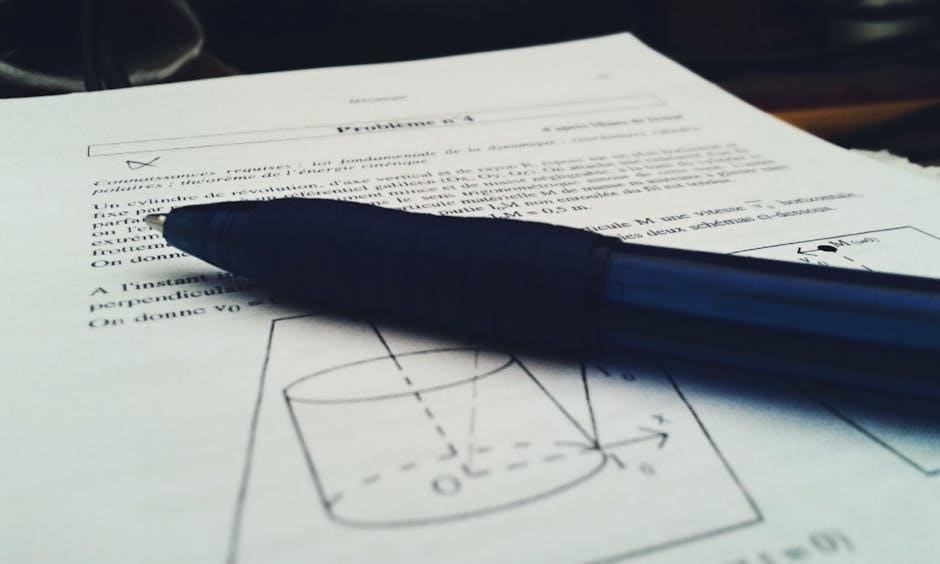AP Physics C: Electricity and Magnetism explores fundamental principles of the universe, focusing on electrostatics, circuits, magnetism, and electromagnetism. It requires calculus and offers comprehensive study guides, textbooks, and practice exams for preparation.
Overview of the Course
The AP Physics C: Electricity and Magnetism course is a challenging, calculus-based study of fundamental physical principles. It is divided into five units: Electrostatics, Conductors and Capacitors, Electric Circuits, Magnetic Fields, and Electromagnetism. Students explore topics such as electric charges, fields, circuits, and magnetic forces, with a strong emphasis on problem-solving and analytical thinking. The course requires a solid understanding of calculus and prepares students for advanced physics studies. It is designed to develop critical thinking and mathematical skills through hands-on problem-solving and theoretical analysis. Resources like textbooks, online guides, and practice exams are essential for mastering the material and excelling on the AP exam.
Key Concepts and Topics
AP Physics C: Electricity and Magnetism covers essential topics like electric charges, fields, and potential, as well as circuits, magnetism, and electromagnetic induction. Students learn about Coulomb’s Law, Gauss’s Law, and Ampère’s Law, which are foundational for understanding electric and magnetic fields. The course also delves into capacitors, dielectrics, and energy storage, preparing students to analyze complex systems. Magnetic materials and Maxwell’s Equations are introduced to provide a comprehensive understanding of electromagnetism. These concepts are reinforced through problem-solving strategies and practical applications, ensuring a deep grasp of both theoretical and experimental aspects of the subject. Mastery of these topics is crucial for success on the AP exam and beyond.
Importance of Calculus in AP Physics C
Calculus is integral to AP Physics C: Electricity and Magnetism, as it provides the mathematical tools to analyze and model complex phenomena. Concepts like differentiation and integration are essential for understanding electric fields, flux, and charge distributions. Calculus enables students to derive fundamental laws, such as Gauss’s Law and Ampère’s Law, and solve problems involving continuous charge distributions. It also simplifies circuit analysis, particularly in dynamic systems with time-varying currents and voltages. Mastery of calculus is crucial for tackling advanced topics and solving the rigorous, application-based problems typical of the AP exam. This mathematical foundation prepares students for college-level physics and engineering courses.

Unit 1: Electrostatics
Unit 1 introduces electric charges, Coulomb’s Law, and electric fields, forming the foundation for understanding electrostatic interactions and their practical applications in physics.
Electric Charges and Forces
Electric charges and forces are foundational concepts in AP Physics C: Electricity and Magnetism. This section explores the nature of electric charges, including positive, negative, and neutral charges, and their interactions. Coulomb’s Law is introduced to describe the force between two point charges, emphasizing the influence of distance and charge magnitude. The principle of superposition is also covered, explaining how forces from multiple charges combine. Key ideas such as charge quantization and conservation are discussed, providing a theoretical framework for understanding electrostatic phenomena. Practical applications and problem-solving strategies are highlighted to reinforce these concepts. This section forms the basis for analyzing electric fields and potentials in subsequent units.
Electric Fields
Electric fields are vector quantities representing the force per unit charge exerted on a test charge at a specific point in space. They arise from charged objects and are described by Coulomb’s Law. The electric field E due to a point charge is given by E = kQ/r², where k is Coulomb’s constant, Q is the charge, and r is the distance from the charge. Fields can be represented by lines, with direction indicating the force on a positive test charge. Superposition of fields from multiple charges is key. Understanding electric fields is crucial for analyzing capacitors, conductors, and electromagnetic phenomena. Study guides and textbooks provide detailed problems and visualizations to master this concept.
Gauss’s Law
Gauss’s Law relates the distribution of electric charge to the resulting electric field, simplifying complex field calculations. It states that the electric flux through a closed surface is equal to the enclosed charge divided by permittivity: Φ = Q_enc / ε₀. This law is particularly useful for symmetric charge distributions, such as spheres or cylinders, where it simplifies field calculations. Study guides emphasize its application in solving problems involving conductors, capacitors, and dielectrics. Mastering Gauss’s Law is essential for understanding electrostatics and advanced topics like Maxwell’s Equations. Textbooks and online resources provide detailed derivations and practice problems to aid comprehension and application of this fundamental principle.
Electric Potential Energy
Electric potential energy (U) is the energy a charged object has due to its position in an electric field. It is defined as the work done by an external force to move a charge against the electric field. The formula is U = qV, where ( q ) is the charge and ( V ) is the electric potential. For a system of charges, the total potential energy is the sum of the potential energies of each pair. Electric potential energy is crucial for understanding energy storage in capacitors and systems of charges. Study guides often include problems involving conservation of energy in electric fields, helping students master this fundamental concept in electrostatics.

Unit 2: Conductors, Capacitors, Dielectrics
This unit covers the behavior of conductors and insulators, capacitance, dielectrics, and energy storage in capacitors. It explores how materials respond to electric fields and store energy.
Conductors and Insulators
Conductors allow free movement of charges, enabling electric current, while insulators resist it. Conductors have charges on their surfaces, zero potential difference internally, and electric fields. Insulators have bound charges, minimal current, and varying potential differences. Understanding their behavior under electric fields is crucial for circuits and capacitors, as seen in study guides and textbooks. Practical applications include wiring and energy storage. This topic is essential for mastering electric fields and energy storage, as explored in AP Physics C: Electricity and Magnetism materials. Properly distinguishing conductors from insulators aids in designing circuits and capacitors effectively, a key skill emphasized in practice exams and video tutorials.
Capacitance and Capacitors
Capacitance measures a capacitor’s ability to store electric potential energy. It is quantified by the formula ( C = rac{Q}{V} ), where ( Q ) is charge and ( V ) is voltage. Capacitors consist of two conductors separated by a dielectric, influencing capacitance. Factors like plate area, separation distance, and dielectric material affect ( C ). Capacitors store energy in electric fields, essential for filtering, timing, and energy storage in circuits. Types include parallel plate and spherical capacitors. Study guides and practice exams emphasize calculating capacitance, energy storage, and applications in circuits. Mastering capacitors is vital for understanding energy storage and filtering in electronics, a core concept in AP Physics C: Electricity and Magnetism.
Dielectrics
Dielectrics are non-conductive materials placed between capacitor plates to enhance capacitance. They become polarized, reducing the electric field and increasing stored energy. The dielectric constant (κ) quantifies this effect, with higher κ materials increasing capacitance. Common dielectrics include air, glass, and ceramic. Polarization aligns molecular dipoles with the field, effectively reducing the field’s strength. This allows capacitors to store more charge at the same voltage, enhancing energy storage capacity. Understanding dielectrics is crucial for designing capacitors in electronic circuits. Study guides emphasize calculating capacitance with dielectrics and their practical applications in energy storage and filtering systems.
Energy Storage in Capacitors
Capacitors store electric potential energy in their electric field when charged. The energy stored is given by the formula ( U = rac{1}{2}CV^2 ), where ( C ) is capacitance and ( V ) is voltage. This relationship shows that energy is proportional to the square of the voltage, meaning even small voltage increases significantly boost stored energy. Capacitors are crucial in electronics for tasks like power filtering and supplying energy during failures. They are also used in cameras for flashes and audio equipment for smooth power supply. Understanding energy storage is vital for designing circuits and safely managing energy in capacitors, especially with dielectrics affecting capacitance and energy capacity;
Unit 3: Electric Circuits
Electric circuits involve the flow of electrical energy through resistors, capacitors, and other components. Key concepts include Ohm’s Law, Kirchhoff’s Laws, and energy transfer in circuits.
Resistors and Resistance
Resistors are essential components in electric circuits, opposing the flow of electric current. Resistance, measured in ohms, depends on material, length, and cross-sectional area. Understanding resistor behavior is crucial for analyzing circuits, as it affects voltage, current, and power. Resistors can be combined in series or parallel, following specific rules. The study of resistors involves Ohm’s Law, which relates voltage, current, and resistance. Calculus is used to analyze non-ohmic materials and transient circuits. Practice problems and lab experiments help solidify concepts. Mastering resistors and resistance is fundamental for AP Physics C, enabling deeper understanding of circuit dynamics and energy distribution. Regular practice with circuit problems is recommended.
Kirchhoff’s Laws
Kirchhoff’s Laws are essential for analyzing complex electric circuits. The Current Law (KCL) states that the sum of currents entering a junction equals the sum leaving it. The Voltage Law (KVL) states that the sum of voltage changes around a closed loop is zero. Together, these laws enable solving for unknown currents and voltages in multi-loop circuits. They are particularly useful in circuits with multiple resistors and power sources. Practical applications include circuit design and troubleshooting. Regular practice with circuit problems helps master these concepts. Calculus is often used to extend these laws to transient circuits. Understanding Kirchhoff’s Laws is vital for AP Physics C and advanced circuit analysis.
RC Circuits
RC circuits, consisting of resistors (R) and capacitors (C), are fundamental in understanding energy storage and transfer. When charged, capacitors store electrical energy, while resistors control the flow of charge. The time constant (τ = RC) determines how quickly a capacitor charges or discharges. Charging follows an exponential curve, reaching 63.2% of its maximum charge in one time constant. Discharging reverses this process. Calculus is used to derive the charging and discharging equations. Practical applications include timing circuits and filtering. Mastering RC circuits involves solving problems with varying resistor and capacitor values. Practice with both calculator and conceptual questions is essential for success in AP Physics C. Regular review ensures a strong grasp of transient circuit behavior.
Electric Power and Energy
Electric power and energy are crucial concepts in AP Physics C, focusing on the relationship between voltage, current, and resistance. Power, measured in watts (W), represents energy transfer per unit time. Key formulas include ( P = VI ), ( P = rac{V^2}{R} ), and ( P = I^2R ). Energy, in joules (J), is the work done to move charges. Understanding these concepts is vital for analyzing circuits and devices. Practical applications include calculating energy consumption in household devices and optimizing power delivery systems. Mastery involves solving problems with varying voltages, currents, and resistances. Regular practice with both theoretical and numerical problems ensures a strong understanding of energy and power in electrical systems.

Unit 4: Magnetic Fields
Unit 4 delves into magnetic fields, forces, and materials, exploring concepts like Ampère’s Law and magnetic flux. It bridges electricity and magnetism, forming the core of electromagnetism.
Magnetic Forces and Fields
Magnetic forces and fields are foundational in understanding how charged particles interact in magnetic environments. The Lorentz force law describes the force on a moving charge in a magnetic field, while the magnetic field itself is characterized by its strength and direction. Students explore the relationship between magnetic fields and their sources, such as currents. Key topics include the magnetic force on a current-carrying wire, torque on a loop, and the application of the right-hand rule. Practical examples, like motors and magnetic materials, are emphasized. Study guides recommend focusing on vector calculations and visualizing field lines. Online resources, such as video tutorials, help clarify complex concepts.
Ampère’s Law
Ampère’s Law is a fundamental principle in magnetism, linking the magnetic field around a closed loop to the current passing through it. It states that the line integral of the magnetic field (B) around a closed path equals μ₀ times the enclosed current (Iₑₙₓ). This law is essential for calculating magnetic fields in symmetric geometries, such as long straight wires, solenoids, and toroids. By choosing an appropriate Amperian loop, students can simplify complex calculations. The law is often used with Maxwell’s correction for time-varying fields. Study guides and video tutorials emphasize solving problems involving Ampère’s Law, highlighting its importance in understanding magnetic field behavior in various configurations. Practice exams also test mastery of this concept.
Magnetic Materials
Magnetic materials are substances that exhibit magnetic properties, such as being attracted to a magnet or exhibiting magnetic fields. Common types include ferromagnetic (e.g., iron, nickel), paramagnetic, and diamagnetic materials. Ferromagnetic materials can be magnetized and retain their magnetic properties, while paramagnetic and diamagnetic materials exhibit weak magnetic behaviors. The magnetic properties of these materials are influenced by their atomic structure and external factors like temperature; Understanding magnetic materials is crucial for applications in electromagnetism, such as in transformers, motors, and magnetic storage devices. Study guides and textbooks provide detailed explanations of these materials, while practice problems help reinforce key concepts like hysteresis loops and the Curie temperature, which determine when materials lose their magnetic properties.
Magnetic Flux and Induction
Magnetic flux measures the strength of a magnetic field passing through a surface, calculated as Φ = BAcosθ. Faraday’s Law of Induction describes how changing flux induces an electromotive force (EMF) in a loop of wire. This fundamental concept explains phenomena like transformers and generators. Lenz’s Law details the direction of induced currents, opposing the change in flux. Study guides emphasize problem-solving techniques for flux calculations and induced EMF. Textbooks provide detailed derivations, while video tutorials offer visual explanations. Practice exams test understanding of flux through various geometries and materials, ensuring mastery of electromagnetic induction principles. These resources are essential for grasping this core topic in AP Physics C: Electricity and Magnetism.
Unit 5: Electromagnetism
Electromagnetism unites electricity and magnetism, exploring electromagnetic induction, Faraday’s Law, Maxwell’s Equations, and electromagnetic waves. Study guides and textbooks provide in-depth explanations and problem-solving strategies for mastering these concepts.
Electromagnetic Induction
Electromagnetic induction, a cornerstone of electromagnetism, describes how a changing magnetic field induces an electric field. Faraday’s Law quantifies this phenomenon, linking induced EMF to the rate of magnetic flux change. Lenz’s Law explains the direction of induced currents, opposing the change in flux. Maxwell’s Equations unify these concepts, forming the basis of electromagnetic theory. Study guides and textbooks provide detailed derivations and problem-solving techniques. Video tutorials and practice exams help students master applications, such as generators and transformers. Understanding induction is crucial for grasping wave propagation and modern technologies. Resources emphasize visualization and mathematical rigor, ensuring a deep comprehension of this fundamental principle.
Faraday’s Law
Faraday’s Law of Induction states that a changing magnetic flux through a loop induces an electromotive force (EMF). Mathematically, ε = -N(dΦ_B/dt), where N is the number of loops and dΦ_B/dt is the flux change rate. Lenz’s Law determines the induced current’s direction, opposing the flux change. This principle underpins transformers, generators, and inductors. Study guides and textbooks provide detailed derivations and applications, while video tutorials simplify complex concepts. Practice problems and exams help master calculation techniques. Understanding Faraday’s Law is essential for advanced topics like electromagnetic waves and Maxwell’s equations, making it a cornerstone of AP Physics C: Electricity and Magnetism.
Maxwell’s Equations
Maxwell’s Equations are four fundamental laws in electromagnetism, formulated by James Clerk Maxwell. They unify the theories of electricity and magnetism into a coherent whole.
- Gauss’s Law for Electricity: Relates electric flux through a closed surface to the enclosed charge (∮ E · dA = Q_enc / ε₀).
- Gauss’s Law for Magnetism: States that magnetic flux through a closed surface is zero (∮ B · dA = 0), indicating no magnetic monopoles.
- Faraday’s Law: Describes how a time-varying magnetic field induces an electric field (∮ E · dl = -dΦ_B / dt).
- Ampère’s Law with Maxwell’s Addition: Relates the magnetic field to the enclosed current and displacement current (∮ B · dl = μ₀ I_enc + μ₀ ε₀ dΦ_E / dt).
These equations describe how electric and magnetic fields are generated and altered by charges and currents, forming the basis for electromagnetic wave propagation.
Electromagnetic Waves
Electromagnetic waves are oscillations of electric and magnetic fields that propagate through space. Derived from Maxwell’s Equations, they result from accelerating charges or changing electric fields. These waves, such as light, radio waves, and X-rays, travel at the speed of light in a vacuum and consist of perpendicular electric and magnetic fields. Key principles include wave speed (c = 1/√(μ₀ε₀)) and the electromagnetic spectrum, which categorizes waves by frequency and wavelength. Understanding wave properties, such as polarization and interference, is crucial for solving problems in electromagnetism. These concepts are essential for advanced topics like optics and communications, making them a cornerstone of AP Physics C.

Study Resources and Materials
Essential resources include textbooks like Barron’s and Princeton Review, online guides, and practice exams. Video tutorials and study sheets provide focused explanations and practice questions for mastery.
Recommended Textbooks
Barron’s AP Physics C and Princeton Review AP Physics C are highly recommended for in-depth preparation. These textbooks offer comprehensive coverage of electricity and magnetism, with practice exams, detailed solutions, and focused explanations. Barron’s is known for its challenging questions, while Princeton Review provides clear, concise concepts. Additional resources like Physics C (Electricity & Magnetism) Passbook and AP Physics C Tutorials/Guide Sheets are also valuable for targeted study. These materials are designed to help students master complex topics, such as electromagnetism and circuits, and prepare effectively for the AP exam. They complement online guides and video tutorials, ensuring a well-rounded study approach.
Online Study Guides
Online study guides are essential for supplementing AP Physics C: Electricity and Magnetism preparation. Websites offer detailed notes on electric circuits, magnetic fields, and electromagnetism. Video tutorials provide visual explanations of complex topics like Faraday’s Law and Maxwell’s Equations. Interactive simulations allow students to explore concepts such as electric fields and capacitance. Additionally, forums and discussion groups enable students to ask questions and share insights. These resources are particularly useful for self-study, offering flexible learning opportunities. They complement textbooks and practice exams, ensuring a comprehensive understanding of the course material. Utilizing online guides can significantly enhance problem-solving skills and exam readiness.
Practice Exams
Practice exams are a crucial tool for preparing for the AP Physics C: Electricity and Magnetism exam. They simulate real test conditions, helping students assess their readiness and identify areas for improvement. Resources like the Barron’s and Princeton Review books offer practice exams that closely mirror the actual test format. These exams include challenging questions that cover topics such as electric circuits, magnetic fields, and electromagnetism. By completing practice exams, students can refine their problem-solving strategies and time management skills. Additionally, some online platforms provide practice exams with detailed solutions, enabling students to review and understand their mistakes. Regular practice exams are essential for achieving a high score on the AP test.
Video Tutorials
Video tutorials are an excellent resource for visual learners preparing for AP Physics C: Electricity and Magnetism. Platforms like Khan Academy and 3Blue1Brown offer engaging explanations of complex topics such as electromagnetism and electric circuits. These tutorials break down difficult concepts into digestible parts, often with animations and real-world examples. They are particularly helpful for understanding abstract ideas like magnetic fields and Maxwell’s equations. Many videos also include step-by-step solutions to practice problems, allowing students to follow along and improve their problem-solving skills. Additionally, video tutorials provide flexibility, enabling students to review material at their own pace. They are a valuable supplement to textbooks and study guides, making them an essential tool for mastering AP Physics C.

Preparation Strategies
Effective preparation for AP Physics C requires a structured approach, combining active learning, consistent problem-solving practice, and strategic time management to master complex topics and exam techniques.
Time Management
Effective time management is crucial for success in AP Physics C. Create a structured study schedule, balancing topic review, problem-solving, and practice exams. Allocate specific time blocks for each unit, ensuring consistent progress. Prioritize challenging areas like electromagnetism and circuits, dedicating extra time to master complex concepts. Regular review sessions help reinforce understanding and retention. Utilize study guides and online resources to focus on weak areas. Practice exams under timed conditions simulate test-day scenarios, improving speed and accuracy. Maintain a steady pace, avoiding cramming, to ensure comprehensive preparation. Consistency and adaptability in your study plan are key to achieving exam success.
Active Learning Techniques
Engage with the material actively to deepen your understanding of AP Physics C concepts. Use video tutorials to visualize complex ideas like electric fields and magnetism. Participate in study groups to discuss challenging topics and collaborate on problem-solving. Teach concepts to others, as explaining ideas reinforces your own knowledge. Apply hands-on experiments or simulations to explore phenomena like circuits and electromagnetism. Regularly test yourself with practice problems to identify gaps in understanding. Active learning fosters a deeper connection with the material, enhancing retention and critical thinking skills essential for success in the course and exam.
Problem-Solving Strategies
Mastering problem-solving strategies is crucial for success in AP Physics C. Start by breaking down complex problems into simpler, manageable parts. Identify knowns and unknowns, and sketch diagrams to visualize the situation. Use derivations and equations judiciously, ensuring units are consistent. Apply conceptual understanding rather than memorizing formulas. Practice with example problems to refine your approach. Focus on energy conservation, charge conservation, and symmetry where applicable. Highlight common pitfalls, such as incorrect sign conventions or neglecting vector components. Regularly review mistakes to improve problem-solving accuracy and efficiency. These strategies will enhance your ability to tackle challenging questions effectively.
Final Exam Preparation
Effective final exam preparation for AP Physics C requires a strategic approach. Start by reviewing all course material, focusing on key concepts and frequently tested topics. Utilize practice exams and past papers to familiarize yourself with the exam format and timing. Analyze your mistakes to identify weak areas and improve problem-solving skills. Dedicate time to understanding derivations and conceptual relationships, as they often appear in free-response questions. Use study guides and textbooks like Barron’s or Princeton Review for targeted practice. Stay calm and well-rested before the exam to ensure optimal performance. By combining consistent practice with a thorough understanding of the material, you’ll be well-prepared for success.


